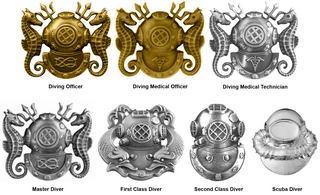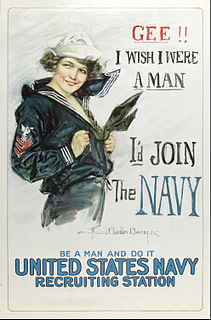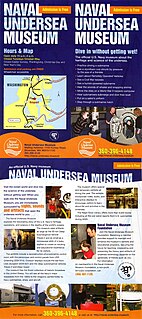
Alvin (DSV-2) is a manned deep-ocean research submersible owned by the United States Navy and operated by the Woods Hole Oceanographic Institution (WHOI) in Woods Hole, Massachusetts. The vehicle was built by General Mills' Electronics Group in Minneapolis, Minnesota. Named to honor the prime mover and creative inspiration for the vehicle, Allyn Vine, Alvin was commissioned on 5 June 1964. The submersible is launched from the deep submergence support vessel RV Atlantis (AGOR-25), which is also owned by the U.S. Navy and operated by WHOI. The submersible has made more than 5,000 dives, carrying two scientists and a pilot, to observe the lifeforms that must cope with super-pressures and move about in total darkness, as well as exploring the wreck of Titanic. Research conducted by Alvin has been featured in nearly 2,000 scientific papers.

The Submarine Warfare Insignia are worn by qualified submariners.

The SSBN Deterrent Patrol Insignia is a uniform breast pin worn by officers and enlisted sailors of the United States Navy's submarine service who have completed strategic deterrent patrols in nuclear ballistic or cruise missile submarines. It is awarded for different criteria than the Submarine Combat Patrol Insignia awarded for submarine patrols during World War II. Design of the SSBN pin shows a silver Lafayette-class submarine with superimposed Polaris missile and electron rings which signify the armament and nuclear-powered characteristics of the Fleet Ballistic Missile Deterrent Force. A scroll beneath the submarine holds up to six award stars, with one gold star authorized for each successful patrol, or a silver star for five successful patrols. At twenty (20) successful patrols, the SSBN pin is upgraded to a gold design. This insignia qualifies the veteran as a combat veteran, making the veteran eligible to join the VFW.

The Submarine Combat Patrol Insignia is a uniform breast pin worn by officers and men of the United States Navy's Submarine Service who have completed combat patrols during declared wars. Such patrols were last conducted during World War II.

The surface warfare insignia is a military badge of the United States Navy which is issued to U.S. Navy personnel who are trained and qualified to perform duties aboard United States surface warships. There are presently four classes of the surface warfare pin, being that of line, staff, special operations, and enlisted. The line and enlisted surface warfare badges may be earned by United States Coast Guard personnel assigned to Navy commands. The various badge types are as follows:

The diver insignia are qualification badges of the uniformed services of the United States which are awarded to servicemen qualified as divers. Originally, the diver insignia was a cloth patch decoration worn by United States Navy divers in the upper-portion of the enlisted service uniform's left sleeve during the first part of World War II, when the rating insignia was worn on the right sleeve. When enlisted rating insignia were shifted to the left sleeve in late World War II, the patch shifted to the upper right sleeve. The diving patch was created during World War II, and became a breast insignia in the late 1960s.

A deep-submergence vehicle (DSV) is a deep-diving manned submarine that is self-propelled. Several navies operate vehicles that can be accurately described as DSVs. DSVs are commonly divided into two types: research DSVs, which are used for exploration and surveying, and DSRVs, which can be used for rescuing the crew of a sunken navy submarine, clandestine (espionage) missions, or both. DSRVs are equipped with docking chambers to allow personnel ingress and egress via a manhole.
There are three major types of submarines in the United States Navy: ballistic missile submarines, attack submarines, and cruise missile submarines. All submarines in the U.S. Navy are nuclear-powered. Ballistic missile submarines have a single strategic mission of carrying nuclear submarine-launched ballistic missiles. Attack submarines have several tactical missions, including sinking ships and subs, launching cruise missiles, and gathering intelligence.
The Career Counselor Badge is a military badge of the United States Army and Navy which was first established in the early 1970s. The badge recognizes those enlisted personnel who have been selected as promotion and career advancement coordinators, and Retention NCO's in the Army. The Navy and Army are the only branches of service to bestow a Career Counselor Badge.

Insignias and badges of the United States Navy are military badges issued by the United States Department of the Navy to naval service members who achieve certain qualifications and accomplishments while serving on both active and reserve duty in the United States Navy. Most naval aviation insignia are also permitted for wear on uniforms of the United States Marine Corps.

Insignia and badges of the United States Marine Corps are military "badges" issued by the United States Department of the Navy to Marines who achieve certain qualifications and accomplishments while serving on both active and reserve duty in the United States Marine Corps.

Trieste II(DSV-1) was the successor to Trieste—the United States Navy's first bathyscaphe purchased from its Swiss designers. The original Trieste design was heavily modified by the Naval Electronics Laboratory in San Diego, California and built at the Mare Island Naval Shipyard. Trieste II incorporated the original Terni, Italian-built sphere used in Trieste, after it was made redundant by the new high-pressure sphere cast by the German Krupp Steelworks. The Trieste sphere was suspended from an entirely new float, more seaworthy and streamlined than the original but operating on identical principles. Completed in early 1964, Trieste II was placed on board USNS Francis X. McGraw (T-AK241) and shipped, via the Panama Canal, to Boston.

A deep-submergence rescue vehicle (DSRV) is a type of deep-submergence vehicle used for rescue of downed submarines and clandestine missions. While DSRV is the term most often used by the United States Navy, other nations have different designations for their vehicles.

The Command at Sea insignia is a badge of the United States' seagoing services worn by officers on their uniforms to denote that they are the commander, or formerly a commander, of a warship. If the wearer is currently the commander of a warship, it is worn above the nametag, which is worn a quarter of an inch above the right chest pocket on a uniform shirt. Afterwards, the pin is moved to the left side of the shirt or jacket. For the commanders of land-based installations, a different but similar version known as the Command Ashore insignia instead.

Turtle (DSV-3) is a 16-ton, manned deep-ocean research submersible owned by the United States Navy. It is sister to Alvin (DSV-2), and also an Alvin class deep-submergence vehicle.
DSV-4 is a 25-ton, manned deep-ocean research submersible owned by the United States Navy, now known only by its hull number, not by its former name.

The United States Navy master diver is the highest warfare qualification obtainable by a member of U.S. Navy diving community. A master diver is an enlisted person who typically has the most experience and knowledge on all aspects of diving and underwater salvage.

The uniforms of the United States Navy include dress uniforms, daily service uniforms, working uniforms, and uniforms for special situations, which have varied throughout the history of the navy. For simplicity in this article, officers refers to both commissioned officers and warrant officers.

The United States Naval Undersea Museum is a naval museum located at Keyport, Washington. It is one of the 10 Navy museums that are operated by the Naval History & Heritage Command. It sits next to a branch of the Naval Undersea Warfare Center.
















